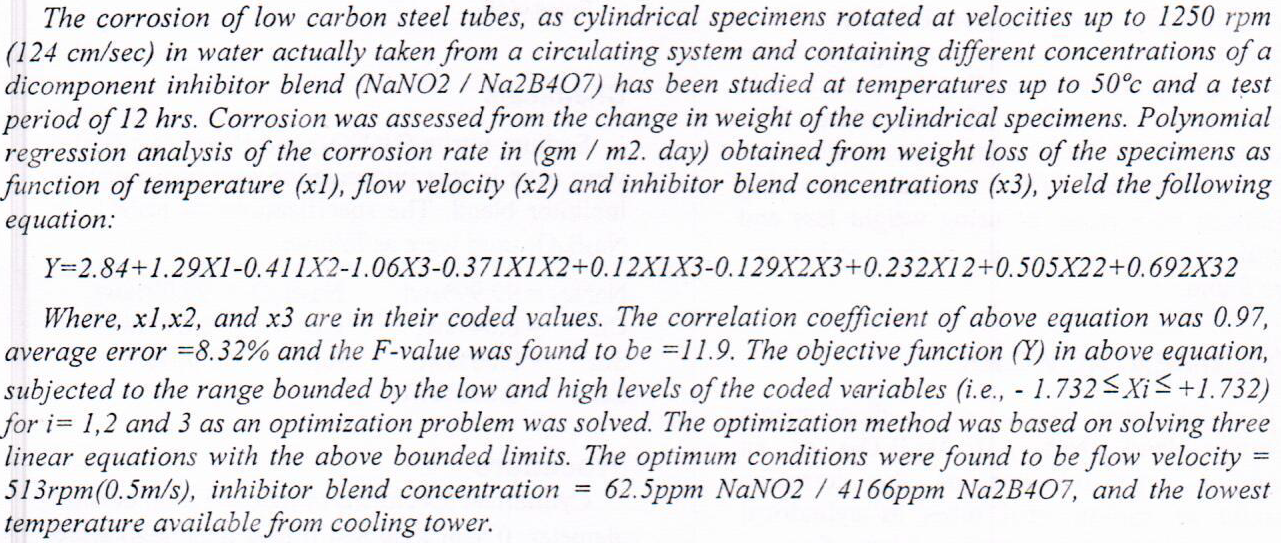
The objective of the present study is to determine the effect of Kaolin as a fuel oil additive to minimize the fireside corrosion of superheater boiler tubes of ASTM designation (A213-T22) by increasing the melting point of the formed slag on the outside tubes surface, through the formation of new compounds with protective properties to the metal surface. The study included measuring corrosion rates at different temperatures with and without additive use with various periods of time, through crucible test method and weight loss technique.
A mathematical model represents the relation between corrosion rate and the studied variables, is obtained using statistical regression analysis. Using this model,
... Show MoreThis research has presented a solution to the problem faced by alloys: the corrosion problem, by reducing corrosion and enhancing protection by using an inhibitor (Schiff base). The inhibitor (Schiff base) was synthesized by reacting of the substrates materials (4-dimethylaminobenzaldehyde and 4-aminoantipyrine). It was diagnosed by infrared technology IR, where the IR spectrum and through the visible beams proved that the Schiff base was well formed and with high purity. The corrosion behavior of carbon steel and stainless steel in a saline medium (artificial seawater 3.5%NaCl) before and after using the inhibitor at four temperatures: 20, 30, 40, and 50 C° was studied by using thr
... Show MoreThis research has presented a solution to the problem faced by alloys: the corrosion problem, by reducing corrosion and enhancing protection by using an inhibitor (Schiff base). The inhibitor (Schiff base) was synthesized by reacting of the substrates materials (4-dimethylaminobenzaldehyde and 4-aminoantipyrine). It was diagnosed by infrared technology IR, where the IR spectrum and through the visible beams proved that the Schiff base was well formed and with high purity. The corrosion behavior of carbon steel and stainless steel in a saline medium (artificial seawater 3.5%NaCl) before and after using the inhibitor at four temperatures: 20, 30, 40, and 50 C° was studied by using three electrodes potentiostat. The corrosion behavior was
... Show More (14)
(14)
 (3)
(3)
This research has presented a solution to the problem faced by alloys: the corrosion problem, by reducing corrosion and enhancing protection by using an inhibitor (Schiff base). The inhibitor (Schiff base) was synthesized by reacting of the substrates materials (4-dimethylaminobenzaldehyde and 4-aminoantipyrine). It was diagnosed by infrared technology IR, where the IR spectrum and through the visible beams proved that the Schiff base was well formed and with high purity. The corrosion behavior of carbon steel and stainless steel in a saline medium (artificial seawater 3.5%NaCl) before and after using the inhibitor at four temperatures: 20, 30, 40, and 50 C° was studied by using three electrodes potentiostat. The corrosion behavior
... Show More (14)
(14)
 (3)
(3)
The driving idea for the present work was to combine the effect of polyvinyl alcohol (PVA) as corrosion inhibitor with the distance between the anodic and cathodic elements of the galvanic cell, beside their area ratio, in scope of synergistic suppression of galvanic corrosion on Cu/Fe model couple, using weight loss method. The performance affecting galvanic corrosion process has been tested for three major factors affect the process:
1. Four PVA inhibitor concentrations were selected to be (0, 1000, 4000 and 7000 ppm) in simulated cooling water.
2. Two cathode: anode area ratios as 1:1 and 2.4:1.
3. Two distances apart cathode – anode as 3 and 7 cm.
Maximum corrosion inhibition achieved was 86% which indicates that increa
Visualization of water flow around different bluff bodies at different Reynolds number ranging (1505 - 2492) was realized by designing and building a test rig which contains an open channel capable to ensure water velocity range (4-8cm/s) in this channel. Hydrogen bubbles generated from the ionized water using DC power supply are visualized by a light source and photographed by a digital camera. Flow pattern around a circular disk of (3.6cm) diameter and (3mm) thickness, a sphere of (3.8cm) diameter and a cylinder of
(3.2cm) diameter and (10cm) length are studied qualitatively. Parameters of the vortex ring generated in the wake region of the disk and the separation angle of water stream lines from the surface of the sphere are plott
 (1)
(1)
 (10)
(10)
 (11)
(11)
In this paper investigate the influences of dissolved CO2/H2S gases, crude oil velocity and temperature on the rate of corrosion of crude oil transmission pipelines of Maysan oil fields southern Iraq. The Potentiostatic corrosion test technique was conducted into two types of carbon steel pipeline (materials API 5L X60 and API 5L X80). The computer software ECE electronic corrosion engineer was used to predict the influences of CO2 partial pressure, the composition of crude oil, flow velocity of crude oil and percentage of material elements of carbon steel on the rate of corrosion. As a result, the carbon steel API 5L X80 indicates good and appropriate resistance to corrosion compared to carbon steel API
... Show More (3)
(3)
The effect of time (or corrosion products formation) on corrosion rates of carbon steel pipe in aerated 0.1N NaCl
solution under turbulent flow conditions is investigated. Tests are conducted using electrochemical polarization
technique by determining the limiting current density of oxygen reduction in Reynolds number range of 15000 to 110000
and temperature range of 30 to 60oC. The effect of corrosion products formation on the friction factor is studied and
discussed. Corrosion process is analyzed as a mass transfer operation and the mass transfer theory is employed to
express the corrosion rate. The results are compared with many proposed models particularly those based on the
concept of analogy among momentum, heat,

